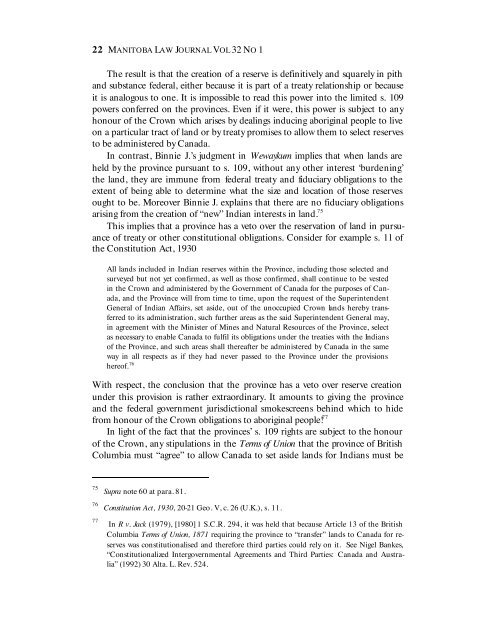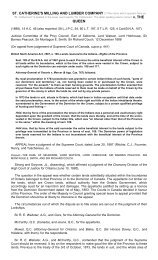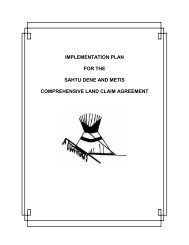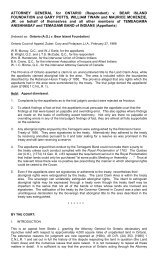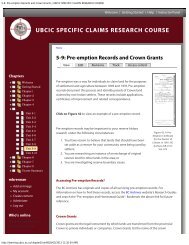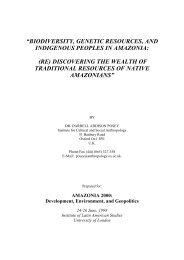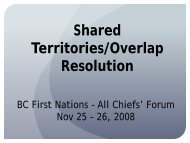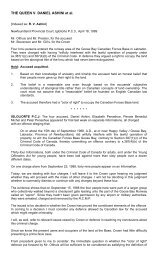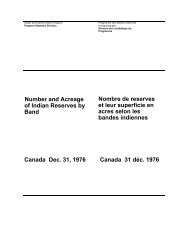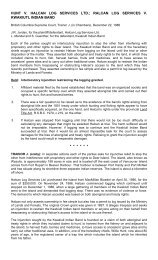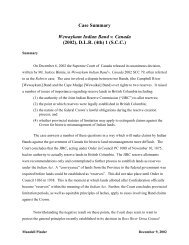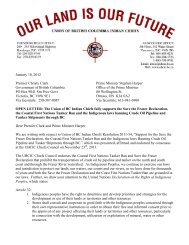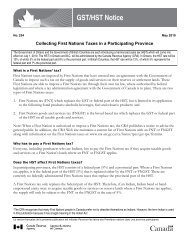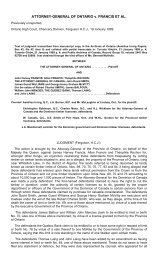Constitutional âPropertyâ and Reserve Creation: Seybold Revisited
Constitutional âPropertyâ and Reserve Creation: Seybold Revisited
Constitutional âPropertyâ and Reserve Creation: Seybold Revisited
Create successful ePaper yourself
Turn your PDF publications into a flip-book with our unique Google optimized e-Paper software.
22 MANITOBA LAW JOURNAL VOL 32 NO 1The result is that the creation of a reserve is definitively <strong>and</strong> squarely in pith<strong>and</strong> substance federal, either because it is part of a treaty relationship or becauseit is analogous to one. It is impossible to read this power into the limited s. 109powers conferred on the provinces. Even if it were, this power is subject to anyhonour of the Crown which arises by dealings inducing aboriginal people to liveon a particular tract of l<strong>and</strong> or by treaty promises to allow them to select reservesto be administered by Canada.In contrast, Binnie J.’s judgment in Wewaykum implies that when l<strong>and</strong>s areheld by the province pursuant to s. 109, without any other interest ‘burdening’the l<strong>and</strong>, they are immune from federal treaty <strong>and</strong> fiduciary obligations to theextent of being able to determine what the size <strong>and</strong> location of those reservesought to be. Moreover Binnie J. explains that there are no fiduciary obligationsarising from the creation of “new” Indian interests in l<strong>and</strong>. 75This implies that a province has a veto over the reservation of l<strong>and</strong> in pursuanceof treaty or other constitutional obligations. Consider for example s. 11 ofthe Constitution Act, 1930All l<strong>and</strong>s included in Indian reserves within the Province, including those selected <strong>and</strong>surveyed but not yet confirmed, as well as those confirmed, shall continue to be vestedin the Crown <strong>and</strong> administered by the Government of Canada for the purposes of Canada,<strong>and</strong> the Province will from time to time, upon the request of the SuperintendentGeneral of Indian Affairs, set aside, out of the unoccupied Crown l<strong>and</strong>s hereby transferredto its administration, such further areas as the said Superintendent General may,in agreement with the Minister of Mines <strong>and</strong> Natural Resources of the Province, selectas necessary to enable Canada to fulfil its obligations under the treaties with the Indiansof the Province, <strong>and</strong> such areas shall thereafter be administered by Canada in the sameway in all respects as if they had never passed to the Province under the provisionshereof. 76With respect, the conclusion that the province has a veto over reserve creationunder this provision is rather extraordinary. It amounts to giving the province<strong>and</strong> the federal government jurisdictional smokescreens behind which to hidefrom honour of the Crown obligations to aboriginal people! 77In light of the fact that the provinces’ s. 109 rights are subject to the honourof the Crown, any stipulations in the Terms of Union that the province of BritishColumbia must “agree” to allow Canada to set aside l<strong>and</strong>s for Indians must be757677Supra note 60 at para. 81.Constitution Act, 1930, 20-21 Geo. V, c. 26 (U.K.), s. 11.In R v. Jack (1979), [1980] 1 S.C.R. 294, it was held that because Article 13 of the BritishColumbia Terms of Union, 1871 requiring the province to “transfer” l<strong>and</strong>s to Canada for reserveswas constitutionalised <strong>and</strong> therefore third parties could rely on it. See Nigel Bankes,“<strong>Constitutional</strong>ized Intergovernmental Agreements <strong>and</strong> Third Parties: Canada <strong>and</strong> Australia”(1992) 30 Alta. L. Rev. 524.


